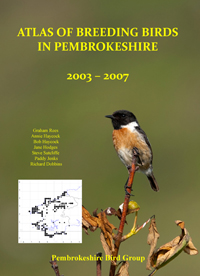Milaria calandra
Former breeding resident.
The Corn Bunting breeds across the middle latitudes of the south west Palearctic. Changing agricultural practices resulted in an 87 % decrease in the UK population between 1967 and 2006 and a 61% decrease across Europe between 1980 and 2005.
The Corn Bunting was a common breeding resident in coastal areas of Pembrokeshire up to the late 19th century. Writing in 1894 Murray Mathew considered them to be local inasmuch as he had never seen one more than five miles from the coast and his correspondents considered them to be plentiful at Pembroke and very abundant in the neighbourhood of Tenby. Their distribution coincided with the main barley growing area of that time. Bertram Lloyd (1939) found a similar coastal distribution in the 1920’s, his diary entries giving some idea of density by noting “all along the cliff hinterland from St Govan’s to Linney , I heard about 10 singing here on the 26th July 1927”. By the 1930’s Lloyd thought they might be decreasing, particularly in the north of the county, and by 1957 Ronald Lockley noted that they had become local and were rapidly decreasing. At this time he also noted that many farms had turned from tillage for cereal production to pasture for milk production. This conversion continued, resulting in the predominant dairy farming of today, with the resultant creation of habitat unsuitable for Corn Buntings.
Breeding Corn Buntings probably disappeared after 1963 when there was still enough activity to produce winter flocks of up to 30 birds in the Gelliswick to South Hook area. Thereafter the species became so rare that individual occurrences were considered worthy of putting on record, viz: singles in 1967, 1968, 1975, 1978, 1981, 1982, 1987, 1991, 1993, two in 1965, 1977, 1979, 1992, three in 1980 and four in 1985. The last Corn Bunting to be recorded in Pembrokeshire was at Ramsey on the 26th August 1993.
It is interesting that a lone bird that frequented the Marloes peninsula from 1977 to 1981 regularly sang like a Yellowhammer. This seems to have been an individual development for single birds at Gilfach Cross in May 1987 and at Llanycefn in May 1992 sang normally.
Graham Rees.
(Covers records up to and including 2008)
References
LLOYD. B. 1929-1939 Diaries, National Museum of Wales.
LOCKLEY. R. M. (1957). Pembrokeshire, Robert Hale, London.
M Mathew, 1894, The Birds of Pembrokeshire and its islands.
 Sunday, July 28, 2013 at 9:11AM
Sunday, July 28, 2013 at 9:11AM  1949 BoP in
1949 BoP in  Corn Bunting
Corn Bunting 


